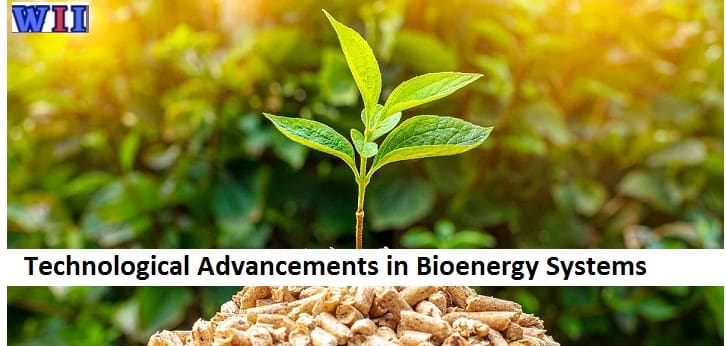Technological Advancements in Bioenergy Systems: Bio energy, sourced from biomass like crop waste, forestry leftovers, and algae, is a renewable energy player with immense potential. By harnessing bio energy, we can cut down greenhouse gas emissions, reduce dependence on fossil fuels, and foster sustainable development. This article will delve into how technological leaps are refining bioenergy systems to boost efficiency, reliability, and environmental compatibility.
Unpacking Biomass Conversion Techniques
Burning it up with Combustion
Traditional combustion systems have long dominated the bio energy landscape, but they’re notorious for low efficiency and high emissions. That’s where advanced combustion technologies step in, offering improved efficiency and reduced pollutant emissions, while handling diverse biomass types.
Gassing it out with Gasification
Biomass classification, a process that transforms low-grade biomass into high-grade energy carriers, has caught attention. By cleaning and using the resulting syngas in combined heat and power systems, we can optimally utilize biomass.
Heating it off with Pyrolysis
Hydrolysis offers two routes. Fast hydrolysis gives us bio-oil, a potential feed stock for biofuels. Slow hydrolysis yields bio char, a soil enhancer and carbon sequestration agent.
Digesting and Fermenting Biomass
Anaerobic digestion and fermentation convert biomass into bio methane and bioethanol, both renewable substitutes for fossil fuels. With advancements, these technologies can now process complex carbohydrates in biomass, not just simple sugars.
The Next Level: Advanced Bio fuels
Green gold: Algae-based Biofuels
Algae, with their high growth rates and oil content, are considered ideal for bio fuel production. Thanks to technology, we’re making strides in efficiently cultivating, harvesting, and converting algae into bio diesel.
Tough stuff: Cellulose Bio fuels
Cellulose bio fuels leverage the inedible parts of plants. Recent breakthroughs in enzymatic hydrolysis, a key step in breaking down cellulose, have made cellulose bio-fuels more viable.

The Power Combo Bio energy and Other Technologies
Bio energy can work hand in hand with solar and geothermal energy, enhancing energy security and cutting carbon emissions. Meanwhile, waste-to-energy technologies are helping us address waste disposal issues while producing renewable energy.
Driving the Future: Bio energy in Transportation
Bio energy in Transportation: Bio ethanol and bio diesel, used in conventional vehicles, can reduce fossil fuel consumption and emissions. Meanwhile, bioelectricity is powering electric vehicles, providing a renewable alternative to fossil fuels and offering a storage solution for the energy.
Storing it up: Energy Storage for Bioenergy Systems
Thermal energy storage technologies and advanced battery systems allow efficient storage and release of energy, smoothening out the energy supply and enhancing system performance.
A Greener Footprint: Environmental and Sustainability Aspects
Life cycle assessments of bioenergy systems show a significant reduction in greenhouse gas emissions. Technological innovations in carbon capture and sustainable biomass production practices are further reducing the environmental impact.
The Business Side: Policy and Market Trends
Government incentives, renewable energy policies, and support programs are propelling bio energy production and use. Consequently, the bio energy market is projected to grow significantly, creating myriad investment opportunities.
Road Ahead: Challenges and Future Directions
Despite the progress, feed stock availability, conversion efficiency, and scalability issues persist. However, with emerging technologies such as artificial photosynthesis and synthetic biology, the future of bio energy looks bright.

The Grand Wrap Up
In a nutshell, technology is at the heart of the transformation happening in the bio energy landscape. It’s paving the way for a sustainable energy future, where bio energy plays a central role. But to harness the full potential of bio energy, we must tackle technical barriers, ensure sustainability, and create a conducive policy environment.
FAQs About Technological Advancements in Bioenergy Systems
Q1 What is bio energy?
Ans: Bio energy is renewable energy derived from organic materials like crop residues, forest waste, energy crops, and algae.
Q2 How does biomass classification work?
Ans: Biomass classification partially burns biomass under limited oxygen to produce syn gas, a combustible gas mixture primarily of carbon monoxide and hydrogen.
Q3 What are cellulose bio fuels?
Ans: Cellulose bio-fuels are derived from the inedible parts of plants. They represent the next generation of bio fuels.
Q4 How does bio energy interact with other renewable energy sources?
Ans: Bio energy can be integrated with solar and geothermal energy to enhance energy security and reduce carbon emissions.
Q5 What are some challenges faced by the bio energy sector?
Ans: The sector faces challenges related to feed stock availability and quality, conversion efficiency, and scalability of bio energy technologies.
Our Reader’s Queries
What are the technologies for bioenergy?
Thermochemical conversion is the most effective way to transform biomass into biofuel. This process involves various techniques such as combustion, torrefaction, pyrolysis, hydrothermal liquefaction, and gasification. These thermochemical technologies are highly practical and efficient in producing biofuels. Asadullah et al. have extensively researched and documented the benefits of these methods. By utilizing these techniques, we can effectively convert biomass into biofuel and contribute towards a sustainable future.
What are the technologies used in biomass?
The majority of biomass thermochemical conversion methods involve pyrolysis, hydrothermal liquefaction, gasification, combustion, torrefaction, and incineration, as outlined in Table 2. This table provides an overview of thermochemical technologies currently in use.
What improvements and technological advances have been made over time for biomass?
The efficiency and versatility of biomass conversion have been greatly enhanced by innovative technologies like pyrolysis, gasification, and anaerobic digestion. These cutting-edge methods make it possible to produce biofuels, biogas, and other valuable products from a diverse range of feedstocks. Thanks to these advancements, we can now extract more value from biomass than ever before.
What are the emerging biomass technologies?
New and exciting ways to make use of biomass are on the rise. These include integrating biorefinery processes, adopting circular bioeconomy practices, and creating biobased materials. With these innovative technologies, we can make the most of our natural resources and reduce waste.

